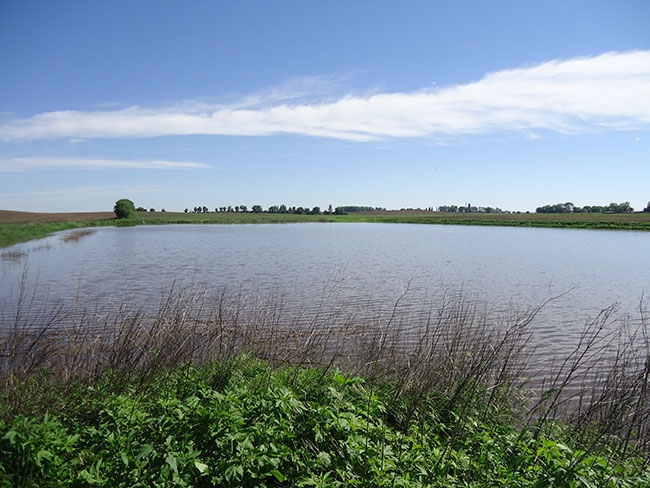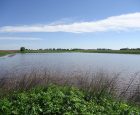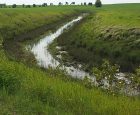
Features
Drainage Management Systems
Q+A: Managing flows with multi-purpose drainage
Multi-purpose drainage management best practices.
August 1, 2017 By Jannen Belbeck
 Blue Earth County Ditch No. 57 “Klein Pond.” Holding capacity of 26 acre-feet treating approximately 2 Multi-purpose drainage management best practices.
Blue Earth County Ditch No. 57 “Klein Pond.” Holding capacity of 26 acre-feet treating approximately 2 Multi-purpose drainage management best practices.We see the impact of phosphorus and nitrogen losses to waterways every summer in bodies of water like the Gulf of Mexico and Lake Erie. Although other environmental elements and human inputs are factors, the runoff from farmers’ fields has always been viewed as the primary culprit.
However, farmers need fertilizer to facilitate crop growth and they also need adequate drainage for healthier plants. Multi-purpose drainage management plans serve as a way to reduce nutrient runoff and mitigate the issues these bodies of water experience every summer.
Chuck Brandel, senior civil engineer with ISG, in Mankato, MN, outlines some of the key components of these systems and the potential implications for drainage contractors.
Can you explain what a multi-purpose drainage management (MDM) plan is?
A multi-purpose drainage management plan is a plan that looks at an agricultural drainage watershed and identifies the best areas where best management practices (BMPs) can be implemented. So [ISG] looks at both the public infrastructure (public ditches, public tile) and then the farmers’ or landowners’ land and where we can implement BMPs on the land to either treat or store runoff.
We look at three different types of control measures, or BMPs: preventative, control and treatment. Preventative are those that can [be implemented] on-field (tillage management, cover crops, nutrient management). Control measures are ways to slow down or control the water (controlled drainage, alternative inlets or alternative side inlets) and treatment measures are ways to treat the water (wetlands, storage ponds).
Any time you slow down the water and store it, if you have some native plants or deep-rooted plants, or any area where you can hold the water and drop sediment out, you’re taking nutrients out of the water because they are either getting taken up by the plants or settling out in the bottom of a basin and not running downstream.
On the ag landscape we’ve been targeting phosphorus and nitrogen. Phosphorus we’ve been treating with storage ponds and wetlands; nitrogen we’ve been using wood chip bioreactors and saturated buffers.
How important are the farmers or landowners in the process of implementing MDM?
In Minnesota the drainage law for any public drainage system was changed in 2014. [It] stated that any project must consider an MDM. It doesn’t say you [have to] implement it but you need to consider it – look at the options, look at the cost. So, for any public drainage system, it’s a requirement that we do an MDM plan but not implement it.
Farmers need to make money but at the same time, they need to be conscious of what’s happening downstream of them. Some of these BMPs can actually save them money over time if we can keep soil on the landscape [and] keep it out of ditches that need to be maintained or cleaned.
The other thing that we’ve looked at is systems that have a very poor, undersized tile system and if we sacrifice one area [where] we can store some water, we can downsize the rest of the area but then not worry about having any negative effects downstream. Minnesota law requires that we look at the outlet – it needs to be adequate before any changes to a public drainage system are completed. Landowners or farmers can improve drainage in your watershed even if you have a poor outlet.
What’s the role of a drainage contractor with regards to these MDM plans? Do they play a role?
Definitely. A lot of the practices that I do are on the large public system, but there are a lot of practices that can be done on private landowners’ properties. And the drainage contractors are the ones that really manage those properties from a drainage perspective for the landowners. I see a future for drainage contractors to be installing many of these. [Nationally], with the NRCS [Natural Resources Conservation Service] and some of their projects, contractors can become technical service providers (TSPs) and do some of the design and layout.
Can these BMPs be considered a one-size-fits-all approach to MDM?
The preventative measures somewhat are. The tillage management, nutrient management, crop rotations, cover crops – those things can be done on a variety of fields; the other ones, not so much. Controlled drainage you have to have a large, very flat area where you can control a lot of water elevation. Two-stage ditches require a certain size watershed and you need certain slopes to be able to maintain a narrow channel. Storage areas or wetlands: if your watershed is dead flat, there might not be a spot where you can store water because you’ll flood everybody. So there’s not a one-size fits all; that’s why we look at the whole watershed. Identify all the ideas, show them to the landowners and we pick the ones that we think can be the most easily implemented.
Right now we’re doing a lot of what we call WASCOBs or water sediment control basins. They are side inlets on the sides of ditches that temporarily hold water. There’s funding for those, they don’t take any more land if you are implementing a buffer or have a buffer, which is state law now. And there’s funding available for them – we’re getting 75 percent cost share in many areas.
I guess there are certain control measures that are more attractive to landowners and to contractors. What’s the feedback you’ve gotten as far as what people are doing?
Side inlets are probably the most popular choice right now from a numbers standpoint. We’ve also used some in-channel storage with a rate control weir. Rate control we’ve done a couple of different ways. One is we put a weir in the channel where we have a ditch that has an area that is deeper than it needs to be. In one example, the end of the ditch system had a steeper slope than the rest and all of the tile coming into the ditch was six feet from the bottom. We put in a concrete wall with an 18-inch opening in an area that had probably a 12-foot wide bottom. This allows the water to build up about five feet and then it can spill over this weir. That way we don’t back up any tiles or put any undue pressure on these tiles. We do this part of the ditch for a temporary storage area. That’s been very popular because we don’t take extra land to store water. The WASCOBs or side inlets temporarily store some water in the field but we design them to drain down in 48 hours or less, so we can maintain whatever crop is growing. Storage has been, I’d say, [moderately popular] since it takes up land. Wetlands are at the bottom because they take up a lot of land, but we are seeing an increase in the need or demand for wetlands, so that may change.
You mentioned funding previously. Do landowners in Minnesota see any other benefits as well? Do they get compensated for any of these BMPs?
Yes, if storage or wetlands are implemented, landowners will get compensated for land that is taken out of production. Buffers: if it’s part of a public ditch system, landowners can get compensated for the land that the buffer takes up. In some cases some of the WASCOBs that we put in are replacing private side inlets that have deteriorated, so by getting cost share, that can reduce costs, so that’s a benefit to the landowner. We have [also] seen landowners can get compensated for their time to manage a controlled drainage system. Landowners also see the benefit of soil kept on their property and not in the ditch system, which they have to pay to clean out.
With regards to the drainage improvement process, can you explain some of the differences between the repairs and improvements that would need to happen?
A repair is fixing a system to what it was originally designed for, so a repair is much easier to get through, but it does not change any depth or change any capacity in the system. A lot of the tile lines that we see were put in a hundred years ago [and are now] very shallow. Plus, if we have any lighter soils that they’ve gone through, we’ve seen subsidence of those soils where they’ve actually shrunk. We’ve had tiles that were three, four feet in the ground that now have a foot of cover. Subsidence – that goes along with if there’s been any erosion. They’re really not able to function as they were designed and equipment and frost damages them. When we run into that scenario, it forces an improvement because an improvement can gain depth and capacity. The difference with the improvement is that when you start increasing capacity you need to look at if your outlet is adequate. If your outlet is not adequate, then you need to look at some BMPs to control flow – either enough storage or other types of treatment.
What rules or regulations should contractors be aware of, both generally and within the state of Minnesota, with regards to implementing MDM systems?
Generally, if it’s a [Waters of the United States] (we call it a public water here in Minnesota) you’ve got an Army Corps permit you’ve got to review and see if you qualify for that. In Minnesota we have the buffer law that’s now in effect so if a contractor is working in an area and he disturbs a buffer, he has to make sure that he puts that back, or if there is no buffer, he should be talking with that landowner to get that in place to be in compliance. The buffers are required 16.5 feet on all public ditches and 50 feet on public waters and need to be in place by November of 2018.
What other changes do you see for contractors nationally? For example, could they be on the hook to file more paperwork?
Yes. Depending if we do get stricter rules on water quality, they could have added permits that they need [in order to] to ensure the project was installed. From a permitting standpoint, it depends on the condition of your watershed. If you’re a special water or a public water, then you’re required [to have Department of Natural Resources] and Army Corps permits. If you’re not and you’re a public ditch system, then you require drainage authority approval.
Improvements do require a MPCA [Minnesota Pollution Control Agency] construction storm water permit. If you have any public roads that you’re crossing, you have to get permits from whoever the road authority is, whether that’s the state or more on the local level.
But there is potential there could be more permits, especially if treatment is required. You’ll have to prove what type of treatment you’re doing and how much water you’re storing or how much [of the] nutrients you are holding back. We haven’t run into that yet in the ag landscape.
Some of the NRCS practices require a TSP or an engineer to sign off on them, so they may need to get either certified as a TSP or work with an engineer to design the system. If funding is being used for some projects, there’s extra paperwork to get the funding, [either] completed by the landowner or contractor. The other way I can see contractors being affected is that they will need to understand how these new practices work and how to install them.
I’m sure there are some contractors that might not be happy to see any changes, but ultimately it’s for a big benefit in the long run.
Yes, an environmental benefit, correct. What we try to do is find the solutions that are still cost-effective, especially when you’re looking at a large watershed. To upsize a system, there’s a cost to do that, but potentially we’ve had systems where we can do some improvements, add some storage, and it may be less expensive than what potential repairs can be.
I look at each project as an opportunity. It’s an opportunity to do something in a different way than we did 100 years ago or 50 years ago or even 20 years ago.
A hundred years ago many areas were tiled and these systems were put in place, but they are falling apart now. There’s a lot of work to be done because of the age of the infrastructure.
Editor’s note: This interview has been edited and condensed.
ISG assists regional and national private clients as well as state and local governments in creative planning, land development, engineering, and architecture solutions.
Print this page

